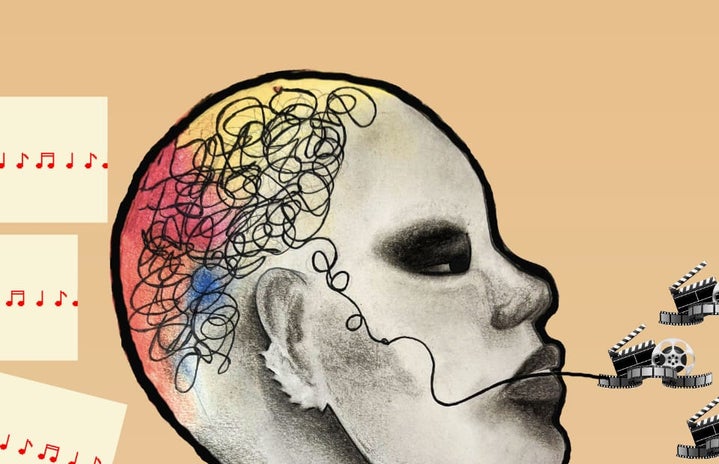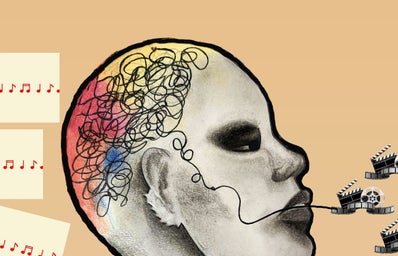According to the WHO, mental health affects one in four people in the world, which is more than 1 billion people. Yet, there is a huge taboo around the discussion of mental health. The growing popularity of media and its multifaceted use, has led to an increase in discussion around mental health. While there has been an increase in the portrayal of mental health leading to increased awareness and more healthy discussions around the same, there has also been romanticization and glorification which proves to be problematic by nulling the effect of the former. Media such as films, television, music and social media have evolved immensely and directly affect the discussions surrounding mental health. Through this article, we aim to look at specific examples from these media to help contextualise how mental health is represented in these forms as well as the impact it creates on its audience.
When it comes to the portrayal of emotions, perhaps one of the strongest artistic mediums of expression is music. The ability of music to convey a variety of emotions allows it to not only highlight the musician’s own experiences through lyrics and production but also impact the listeners and allow them to relate to this music on a personal note. In light of this, music in turn enables a space for the representation of mental health through artists’ own struggles. A perfect example would be 1-800-273-8255 by Logic (the name of the song is the suicide hotline number in the United States), as it has impacted its listeners greatly. The song which represented the singer’s own struggles with severe depression and mental health, spoke to people and thereby furthered the discussion around dealing with depression and asking for help. Such examples have spread the importance and awareness of mental health and led to healthier discussion around it. After this song was performed at the 2017 VMAs, calls to suicide prevention hotlines increased by 50%.
However, bad mental health has also been glorified in art with the prime example of Vincent Van Gogh. His art was said to be inspired by his struggles with mental health and people find ‘beauty’ in this situation. Similarly, Billie Eillish is a young musician who has come forward with her struggles with depression and even converys this through her music. But her music has been romanticized to the point where young teenagers have categorized themselves as ‘misfits’ who are ‘never understood’. It is definitely possible for her fans to have struggled with mental illness and related to her music. Yet, the overall way in suicide, depression and anxiety in her music has been perceived and glorified by her audience has taken the mental health movement back years. If these struggles are underestimated and taken lightly, the seriousness of them is not acknowledged and the conversation around mental health dies down as well.
The growing popularity of social media has changed the way mental health discussions are framed drastically. On one end, social media has also led to increasing awareness around mental health, for example more awareness pages and campaigns being shared and increased discussion around mental health. It has also increased the use of trigger warnings and sensitivity around the usage of words depicting mental health related areas. This increasing discourse around mental health has given users the ability to listen to people’s experiences with mental health struggles and is creating an environment of mutual understanding and kindness. This in turn, also helps people to realise that they are not alone in their struggles and is normalizing these experiences as well.
But on the other hand,social media has led to terms such as ‘depression’ and ‘anxiety’ being used casually. There is also a huge surplus of catchy and trendy quotes and images (on social media websites such as Instagram, Pinterest, Tumblr etc). These posts romanticize bad mental health and suicide by trivializing its seriousness and painting a pretty picture of bad mental health.
Cinema has been exploring human psychology for much longer than most people realize. Over the years, filmmakers across countries and cultures have had their shot at portraying characters that are innately mentally unsound. Most directors either tell the story through such a character, or tell the story for the character. Martin Scorsese’s Taxi Driver (1976) for example, tracks the deterioration of a man’s mental faculties as a result of chronic loneliness. It explores the themes of harrowing apathy, isolation, and cynicism, all through the eyes and psyche of Robert De Niro’s enigmatic anti-hero. On the other end of the spectrum, there’s David O. Russell’s Silver Linings Playbook (2012), which explores society’s interaction with a person suffering from Bipolar disorder. Social stigma concerning mental illnesses isn’t always blatant or pronounced; it’s often as subtle as an eye-roll lurking with ingrained vitriol. The film captures the thin lines between sensitivity and discrimination towards the ones suffering with incredible astuteness.
There are countless other films and Television shows that have focused their lenses on this subject, over the years. Most of them tend to sensationalize the effects of the concerned illness to create a plot. Joaquin Phoenix as ‘The Joker’, albeit a masterclass in method acting, attaches a sense of grandeur to one’s mental instability. And, so do many other exceptionally crafted pieces of cinema. However, a few get it right. Ron Howard’s A Beautiful Mind (2001) is a distinctly accurate representation of schizophrenia first, and an extraordinary film second! Concurrently, HBO changed the rules of primetime television forever, with The Sopranos (1999-2007). The late James Gandolfini personated one of the first anti-heroes on network television, and consequently led the way for countless others. However, his character also suffered from persistent anxiety and depression that only worsened as he expanded his horizons. This brought an unprecedented sense of realism and empathy to the television screen whilst completely changing the way writers thought about protagonists and antagonists alike!
Music, Social Media, and Cinema all have their projections of mental health, now. But, what seems to be the case really is that, as opposed to the 20th century’s indifference and stigmatization of these issues; in the 21st century, we have a lot of shallow romanticization and beautification of them. There is nothing glamorous about being in a mentally unsound place. Directors, songwriters, and content creators must find more responsible ways of portraying their work, to ensure that public opinion about certain mental illnesses isn’t distorted as a result of it. Media as a platform must evolve to tell a story of truth and genuine empathy; not one of impersonal illusions.




